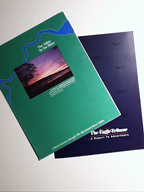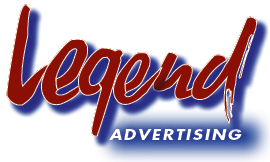
Case Studies
|
Short of a creative assignment, a few case studies to illustrate how we work might be the next best thing. We currently working towards our 17,000th project this year. Creativity
There's nothing like it. There's nothing that can take its place. It's never so obvious as when it's missing. It's the main reason clients come to an advertising agency. And, when all is said and done, it's our only product. Ad agencies have a reputation for being slow, expensive, difficult to deal with, always changing personnel, and especially creative at justifying all of the above. Far from that, however, great advertising agencies have one goal in mind: success for their clients. What is that element that achieves success? It can be that hilariously funny headline, the concept that strikes deep into the heart, the brochure that conveys instantly a credibility that no salesman could ever convey, the press release that fills your office with clippings, or the event that establishes a reputation that does the job. It will never be a great billing department or Steinways in the lobby. It's creativity that will establish your company as a leader, a premier advertiser, and a company of unmistakable quality. It's creativity that ultimately enhances the bottom line by differentiating you from your competition. It takes commitment, consistency, and a relationship of trust and enthusiasm. It's that simple. And that complicated. 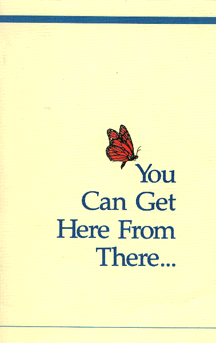 For
example: a company that specializes in substance abuse rehabilitation
and psychiatric care counseling called us. They wanted a map to show
visitors,
who come to their company from all over the country, exactly how to get
there. And, believe me, it's a lot easier to get there the second time.
So instead of just a simple little map (which is what they thought they
wanted) we did a little booklet, entitled "You Can Get Here From
There.'' For
example: a company that specializes in substance abuse rehabilitation
and psychiatric care counseling called us. They wanted a map to show
visitors,
who come to their company from all over the country, exactly how to get
there. And, believe me, it's a lot easier to get there the second time.
So instead of just a simple little map (which is what they thought they
wanted) we did a little booklet, entitled "You Can Get Here From
There.''It starts out innocently enough telling the reader that there are only two roads in, and it asks the reader to decide which way they are going to choose. It counsels them that it doesn't make any difference, because both are confusing and both are difficult, but on one you'll see a chocolate factory and the other you can stop and view one of the world's most famous Revolutionary War paintings. And before the reader can truly decide, this little pamphlet takes him (or her) on a journey through the history of the town, past and present, describing little-known and world-famous things until, from either roadway, the reader finds himself (a free box of homemade candy in hand) standing in the offices of our client. It wasn't the easiest way to do it, but for this customer, it was the right way. It was the only way. Incidentally, the Chamber of Commerce uses this piece to promote the town, with our client's permission, of course.  And then there was the bank
that wanted to improve its image. "People think," they said
to us, "that if they ask us for a loan we'll say 'No!' You must
be able to write an ad that rights that wrong." And then there was the bank
that wanted to improve its image. "People think," they said
to us, "that if they ask us for a loan we'll say 'No!' You must
be able to write an ad that rights that wrong."Well, we thought about it for a while and decided that a new logo, well, not really a new logo, but an additional element in the old logo would fill the bill. So we did an introductory 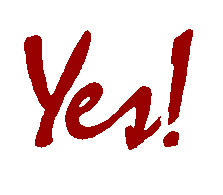 project which included an
ad, a self-mailer with the main message blazing on the outside (postal
people
need loans too!), counter cards at all branches, PR, and the quick incorporation
of the word "Yes!" into the logo, so that wherever the name
of the bank went, a positive impression was sure to follow. project which included an
ad, a self-mailer with the main message blazing on the outside (postal
people
need loans too!), counter cards at all branches, PR, and the quick incorporation
of the word "Yes!" into the logo, so that wherever the name
of the bank went, a positive impression was sure to follow.Today that little $165 million in assets bank is over $600 million and in a world of bank-be-eaten and banks-be-buying, they are buyers; they are players. We went on after that initial project to work for them as a full-service, full-facility advertising agency for four years. We accomplished many things for them including the introduction of new products, annual reports, and area-wide advertising, direct mail, and public relations campaigns that added a very positive note to their annual meetings. And then there's the client we lost....
We could talk about the retailer with three stores who wanted to increase name recognition, begin a "dead-serious" customer retention program, open a new store in a neighboring state, and experiment with radio and television, all in a six-month period culminating in the Christmas season when he hoped to increase his share by about 25% and to do over 50% of his yearly business. We did it ( the agency and the client together). Or we could mention the high-technology conglomerate that called us in to tie five divergent, newly acquired companies together with a corporate image and style, and to begin concurrent advertising programs for each company in all of the major national publications pertinent to their specialties (i.e., semiconductors, multilayered circuit boards, hybrids, testing, and surface mount devices). We were given thirty days to get everything going. At the end of thirty days, five advertising campaigns were running and scheduled for a year, three brochures were done and delivered (trade shows were coming), and public relations campaigns to all national media resources had been completed with lots of coverage resulting. 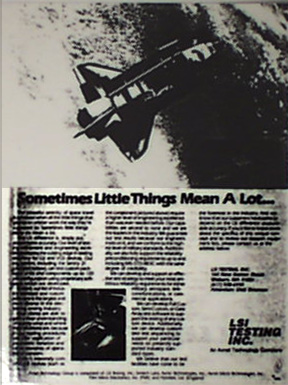 This ad is the lone surviving copy of the working proofs we sent to the national electronic magazine. The other version is the one we completed overnight to avoid the obvious problem. 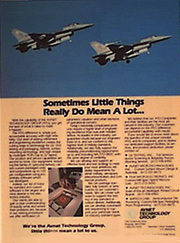 We finished the
other two brochures the following month. Also, we completely
redesigned two ads overnight when the Challenger exploded (the
campaign was centered on high technology and dependability using
the shuttle work the company had done as an example), and initiated
an integrated direct mail campaign aimed at cross selling customers
of all divisions. We finished the
other two brochures the following month. Also, we completely
redesigned two ads overnight when the Challenger exploded (the
campaign was centered on high technology and dependability using
the shuttle work the company had done as an example), and initiated
an integrated direct mail campaign aimed at cross selling customers
of all divisions.And, really, these are just a few examples among many more. And, from all of this experience over the past almost 25 years some things have emerged that always enhance our performance and release the power of creativity:
Reinventing the wheel every day is not something anyone likes to do.
After all, inventing anything is a costly and inherently wasteful venture.
Certainly in advertising it can be. And yet one of the hardest things
to remind a client about is that there are some givens in advertising.
There are some ways of doing things that are proven and dependable.
There are some professionals who know them, and if a client will listen,
we can make it all so much easier. To prove this, a client who would not let us change anything about the format and the thematic direction of the campaign ran the same campaign for over fourteen years. 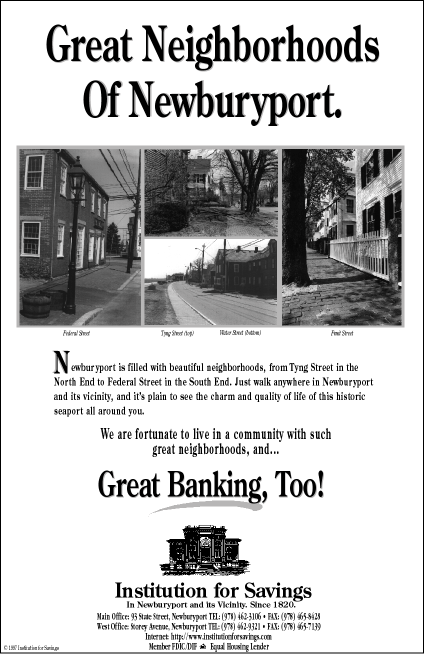 We once made the mistake of creating and presenting an entirely radical new idea. He sat quietly listening, and then threatened to fire us if we pursued it. He said, "Your advertising is the best advertising I've ever had, don't change it. Period." It was hard to walk away from that presentation without mixed emotions. The ads continued to run. And, we actually did introduce television spots that were consistent and compatible (the client carefully scrutinized this), and they also successfully now for many years. We'll come back to this advertiser in the next section on cost-efficiency, but suffice it to say here that even though the ads require original, on-location photography, distinct copy, and a special sense of designing an ad to fit with many others (now over 36 separate ads) in the campaign, he got a great deal of value for the dollar. Because consistency also breeds efficiency. We also have had clients who were indecisive, without direction, and capricious in their opinion on what "good" or "bad" advertising is. For example, in one advertisement we used an expensive cartoon, in another a photograph, in another we used all words, typographically presented. The client kept on trying to be an art director, photographer, typographer, and in general being a real obstruction to the agency's natural creative process. ("Could you move this over here? And that... over there? Let's try this angle, this lighting.") In fact, this type of client is actually very profitable because what would ordinarily be an easy project becomes a behemoth in the time to complete it and on the resultant billings. In point of truth, we steer our clients clear of this or, we steer them to our best competitor. Consistency means agreement, doesn't it? It means that we have all talked it over, and have decided. Together. Creativity is all about quality direction and clear process. And when accomplished, success in marketing your business follows along like a horse and carriage. Just one more word on this important subject. In taking over a very complicated multi-division corporation's marketing and advertising programs, we were asked to meet with groups throughout the country to "focus group" the program as it existed. One of the most frequent words that appeared was "inconsistent." And many people said, "mixed messages." In working this through with the client and integrating our approaches, a lot of wonderful things happened. In the trusting environment that developed, we were able to help them establish their own in-house services such as mechanical preparation and typesetting utilizing their Macintosh systems with which we are so familiar. In doing this we were completely confident that it would not disrupt the program because commitment to graphic standards had become the rule. We eventually designed a graphics manual for them, and they still use us in important creative capacities, and we still earn important billings from our work with the client. But the general good will that developed went way beyond mere advertising. What started as an idea to help their promotional efforts work harder became a company philosophy and a way of doing business. Their in-house efforts are outstanding, and they still have a trusted advertising agency. The best of both worlds. For us, helping our clients get what they want is the only
way. |
legendinc.com | Search | Ask | Archives | Online Store | Contact Us
Ad Info | Employment | Courier Pages | Marblehead Magazine
Stuff of the Day
 A petroleum products distributor
who was advertising on the radio, in Boston and suburban newspapers,
and conducting a regular direct mail program including newsletters,
product flyers, public relations, and special promotions.
A petroleum products distributor
who was advertising on the radio, in Boston and suburban newspapers,
and conducting a regular direct mail program including newsletters,
product flyers, public relations, and special promotions. Then there was a newspaper that
had grown so big it had lost its sense of being from anywhere. They
asked us to help them design and produce a series of brochures that
must do two things: (1) bring in a lot of new business and (2) define
their new area of dominant influence (ADI) to reflect more accurately
the reach of the newspaper.
Then there was a newspaper that
had grown so big it had lost its sense of being from anywhere. They
asked us to help them design and produce a series of brochures that
must do two things: (1) bring in a lot of new business and (2) define
their new area of dominant influence (ADI) to reflect more accurately
the reach of the newspaper.